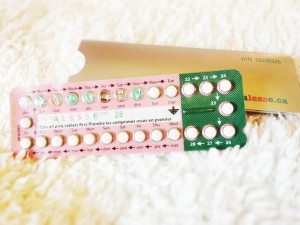The Instruction for Use of Alesse Birth Control
Nowadays even teenagers know about necessity and importance of contraception. After all, condoms, for example, protect not only against unwanted pregnancy but also from possible sexually transmitted diseases. But this article devoted not to them.
My Canadian Pharmacy decided to talk about such concept as an oral contraceptive, in particular, Alesse: its pharmacology, action mechanism, side effects, contraindications and so on.

Alesse Birth Control (Levonorgestrel + Ethinylestradiol)
- Pharmacological class – estrogens, progestins; their antagonists and homologs in combinations.
- Substance characteristics – low-dose monophasic oral combined estrogen-gestagenic contraceptive drug.
- Pharmacological action – contraceptive, estrogen-gestagenic.
Pharmacodynamics
The contraceptive effect is achieved by means of complementary mechanisms, the most important of which include ovulation inhibition and cervical secretion viscosity increase, whereby it becomes impenetrable for sperm cells.
Women using COCs observe more regular menstrual cycle, decreased intensity and painfulness of menstruation-like hemorrhage and as a result reduced asiderotic anemia risk. Moreover, there are data that COCs contribute to endometrial and ovarian cancer risk reduction.
When used properly, Pearl Index (an indicator of pregnancy rate among 100 women during one year of contraceptive application) is less than 1. In case of Alesse reception omission or improper administration, Pearl Index may increase.
Pharmacokinetics
Levonorgestrel
Absorption. After ingestion levonorgestrel is rapidly and completely absorbed, the Cmax in blood plasma, which is equal to 4,3 ng/ml, is reached after about 1 hour. Levonorgestrel bioavailability, when taken orally, is almost complete.
Distribution. Levonorgestrel binds to plasma albumin and SHBG. In free-form in blood plasma contains only about 1,3% of total levonorgestrel concentration; about 64% are specifically connected with SHBG, and about 35% are non-specifically connected with albumin. SHBG synthesis induction with ethinylestradiol affects levonorgestrel binding to plasma proteins, causing fraction increase bound to SHBG and fraction decrease bound to albumin. Levonorgestrel seeming Vd is about 184 l after a single dose.
Metabolism. Levonorgestrel undergoes extensive metabolism. Major metabolites in plasma are conjugated and non-conjugated 3α, 5β – tetragidrolevonorgestrel forms. According to in vitro and in vivo studies data, the main enzyme involved in levonorgestrel metabolism is CYP3A4. Clearance from plasma is 1,3 – 1,6 ml/min/kg.
Clearance. Levonorgestrel concentration in blood plasma decreases diphasicly. Half-life period in terminal phase is 20 – 23 hours. Levonorgestrel is not excreted unchanged, metabolites are excreted by kidneys and intestinal tract in the ratio of about 1:1 with the half-life period of about 24 hours.
Css. With daily levonorgestrel administration, its concentration in plasma increases approximately by 4,3 times, reaching Css in the second cycle half. Levonorgestrel pharmacokinetics is affected by SHBG concentration in blood plasma which, when levonorgestrel is applied together with ethinylestradiol, increases by about 1,7 times. At CSS clearance rate is reduced to about 0,7 ml/min/kg.
Ethinylestradiol
Absorption. After ingestion ethinylestradiol is rapidly and completely absorbed. Cmax in blood plasma equal to about 95 pg/ml is reached after about 1 – 2 hours. During absorption and first passage through the liver, ethinylestradiol is metabolized, whereby when taken orally its bioavailability is at an average about 45% (individual differences are within 20 -65%).
Distribution. Ethinylestradiol is almost completely (about 98%) though non-specifically binds to albumin. It induces SHBG synthesis. Ethinylestradiol seeming Vd is 2,8 – 8,6 l/kg.
Metabolism. Ethinylestradiol undergoes presystemic conjugation both in the small intestine mucous membrane and in the liver. The main metabolic route is aromatic hydroxylation. Clearance from plasma rate is 2,3 – 7 ml/min/kg.
Clearance. Ethinylestradiol concentration in blood plasma decreases diphasicly; the first phase is characterized by half-life period of about 1 hour, second – 10 – 20 hours. It is not excreted unchanged. Ethinylestradiol metabolites are excreted by kidneys and intestinal tract in the ratio of 4:6 with the half-life period of about 24 hours.
Css. With daily ethinylestradiol oral administration, its concentration in plasma slightly increases, reaching Cmax 114 pg/mL at the end of the cycle. Considering unstable half-life period in terminal phase and daily oral administration, CSS is achieved in about 1 week.
Application – oral contraception.
Indications
- oral contraception; prevention of unwanted pregnancies;
- menstrual cycle functional disorders (dysmenorrhoea, uterine bleeding, pains during the menstrual cycle);
- premenstrual tension syndrome.
Administration and Dosage
Individual dosage regimen, dependent on drug type. More information can be obtained from a gynecologist.
Before applying Alesse pregnancy should be excluded.
Pills are taken orally, whole with small amounts of water. It is recommended to take this birth control mediation at the same time every day, in the morning or evening.
Usually, administration begins from the 1st – 5th day of menstrual cycle (the 1st day of cycle = 1st day of menstruation), 1 pill a day, and then daily during 21 days, according to medication instructions. After a 7-day break, during which menstruation-like hemorrhage comes, the 21-day treatment course is renewed (for calendar package containing 21 pills).
 If a package contains 28 pills, after administrating the last pill the following 28-day course should be started without break (4 weeks after taking the first pill on the same day of the week).
If a package contains 28 pills, after administrating the last pill the following 28-day course should be started without break (4 weeks after taking the first pill on the same day of the week).
In case menstruation absence before further intake doctors consultation is necessary.
In case pill reception omission, it is necessary as soon as possible to take a missed pill (not later than 12 hours) or contraceptive effect during this cycle may be reduced. If it has been more than 36 hours between pills – it is considered as omission, contraception effect during this cycle cannot be guaranteed. In this case, in order to achieve the reliable contraceptive effect, additional non-hormonal methods of contraception are recommended (except Knaus–Ogino calendar (temperature) method). However, to avoid breakthrough bleeding Alesse reception should be continued from an already opened package. It is important to remember that ovulation and/or blood-tinged discharges risk increases when missing pill intake.
The dosage for therapeutic purposes is determined individually.
Overdose:
- sickness;
- vomiting;
- uterine bleeding.
Cases of toxic effects caused by overdose are not registered.
Treatment: gastric lavage, symptomatic therapy if necessary. There is no specific antidote.
Contraindications
- pregnancy, lactation period;
- hepatitis, biliousness, decompensated cirrhosis, decompensated liver cirrhosis, hepatism, constitutional hyperbilirubinemia (Gilbert’s, Dubin-Johnson and Rotor’s syndrome), liver tumors (hemangioma, liver cancer, including in anamnesis) or expressed skin itch during previous pregnancy; porphyria;
- herpetic infection during pregnancy in anamnesis;
- otosclerosis (aggravated during previous pregnancies);
- thrombosis and thrombembolia (deep venous thrombosis, pulmonary artery thromboembolism, including in anamnesis), coagulopathy with thrombosis tendency;
- severe cardiovascular system diseases (ischemic heart disease, angina, myocardial infarction, arterial hypertension, atherosclerosis, cardiac abnormality, myocarditis);
- cerebrovascular diseases; cerebral circulation disorders (in anamnesis – ischemic stroke, hemorrhagic stroke);
- lipid storage disease, hyperlipemia, severe obesity;
- cholelithiasis, cholecystitis, pancreatitis accompanied by severe hypertriglyceridemia;
- chronic colitis;
- sickle-cell anemia, chronic hemolytic anemia;
- hormone-dependent tumors, including breast or endometrial cancer (including in anamnesis); endometrial hyperplasia;
- diabetes complicated by microangiopathy, retinopathy;
- uterine bleeding of unknown etiology;
- epilepsy (increased seizures frequency), tetany, migraines with focal neurological symptoms in anamnesis;
- severe renal disorders;
- smoking women over 35 years old;
- hypersensitivity to drug components.
Side Effects
Usually, Alesse is well tolerated, side effects are slightly expressed, usually temporary and disappear after 2 – 3 months of continuous use. Side effects occurrence probability is increased when taking hormonal drugs without consultation with a specialist.
Digestive system:
- dyspepsia;
- sickness;
- vomiting;
- hepatitis;
- gallbladder diseases;
- biliousness.
Endocrine system:
- tension;
- breast augmentation;
- body weight changes;
- libido disorders;
- slight spotting (drug withdrawal is not required), breakthrough bleeding (drug must be withdrawn and gynecological examination is required), vaginal candidiasis. Irregular uterine bleeding frequency (both poor and heavy) decreases during next administration courses; Gradually they as a rule are terminated.
Cardiovascular system:
- arterial blood pressure increase;
- thrombosis and thrombembolia of different localization.
Central nervous system:
- mood swings;
- fatigue;
- headaches;
- migraines.
Others:
- chloasma (dark spots, which are more noticeable after prolonged exposure to the sun);
- skin rash;
- alopecia;
- calf muscles seizures;
- increased triglycerides level in blood plasma;
- decreased glucose tolerance;
- increased blood sugar level;
- contact lenses poor tolerance.

Special Instructions and Precautions
- Before the application it is necessary to exclude pregnancy, undergo general medical and gynecological examination (blood pressure measurement, glucose level detection in urine, liver function tests, breast exams, smear cytologic analysis).
- Contraceptive effect is fully manifested 14 days after reception beginning and persists during the 7-day break. In this regard, during first 2 weeks, it is recommended to use additional non-hormonal contraceptives.
- Every 6 months it is recommended to undergo general medical and gynecological examination (including breast exams). In case of long-term use must annual gynecological cytologic examination is required.
Alesse must be withdrawn and appropriate examination must be carries out in case of:
- pregnancy;
- thrombosis, thrombembolia or thrombophlebitis development;
- hepatitis, biliousness, generalized pruritus;
- cerebrovascular disorders;
- myocardial infarction, significant arterial blood pressure increase;
- eye blockage, vision or hearing disorder, exophthalmos, diplopia;
- epileptic seizure frequency increase;
- repeated migraine-like, persistent or unusually severe headaches;
- sharp upper abdominal pains;
- prolonged immobilization;
- any severe chronic disease development.
This contraceptive should be used with caution in combination with:
- ampicillin, rifampicine, chloramphenicol, neomycin, penicillin B, sulfanilamides, tetracyclines, dihydroergotamine, tranquillizers, carbamazepine, phenobarbital derivatives, phenytoin, phenylbutazone, pyrazolone derivatives, ketoconazole (these drugs may reduce the contraceptive effect, so it is recommended to combine them with any non-hormonal method);
- anticoagulants, coumarine or indandione derivatives (prothrombin time monitoring may be necessary and anticoagulant dosage change);
tricyclic antidepressants, maprotiline; beta-blockers (bioavailability may increase and therefore these preparations toxicity); - oral antidiabetic drugs, insulin. Due to steroid hormones influence on glucose tolerance, when receiving estrogen-gestagenic medications, antidiabetic agents dosage may be corrected;
- bromocriptine (effectiveness decreases);
- hepatotoxic drugs, especially dantrolen (increased hepatotoxicity risk, especially at women older than 35 years).







